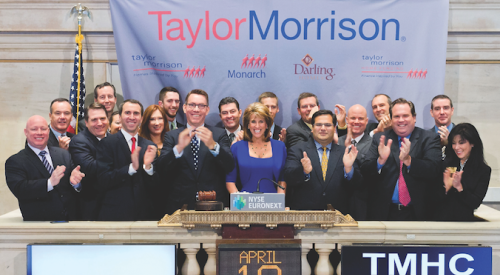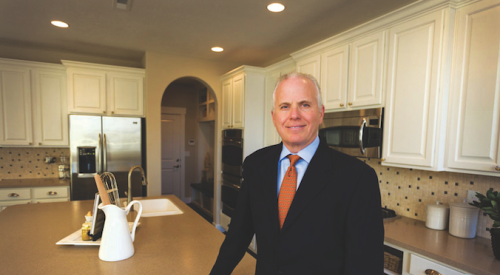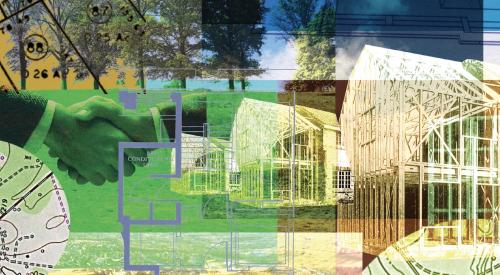Fieldstone Communities' CEO Frank Foster has his Newport Beach, Calif.-based building firm humming in the speedy Rayco business model and climbing Professional Builder's Giant 400 rankings — from No.80 in 2005 to No.48 this year — with a 130 percent increase in closings and 86 percent in revenue. Foster says it's only the beginning.
|
|
The Rayco model, perfected in the early 1990s by Jack Robinson in the namesake San Antonio housing juggernaut, applies manufacturing production and marketing concepts to housing. At Rayco, Robinson continuously surveyed all buyers of new and existing homes throughout the San Antonio market to pinpoint exactly what people pay for rather than what they want. Rayco learned to value-engineer homes to maximize square footage, often using 8-foot ceilings and no vaulted spaces. Many of the features competitors included in base prices, such as fireplaces and microwave ovens, Rayco offered as options. The firm pioneered large design centers to sell these upgrades, but with one important caveat: every item carried exactly the same margin as the base house — never more, never less. The goal was to sell more houses, not options. The design center was not a profit center.
Rayco regularized all work, not just construction, to flow through the firm evenly — and quickly. In the field, the drumbeat dictated the same number of houses be started, framed, finished and closed each day. Rayco achieved market share of more than 60 percent in San Antonio before KB Home acquired the firm in 1996. At that time, Rayco was building more than 2,600 homes a year.
In 2005, Fieldstone used its own version of the model to close 1,622 single-family detached homes in Southern California, Salt Lake City and San Antonio — revenues of $618.7 million. San Antonio now plays a critical role in Foster's strategy to reshape Fieldstone.
"We're hitting that market with the same compelling value proposition Rayco used," Foster says, "providing strong value at the lower price points — selling houses that are large in square footage but very quick to build. From trench to close, we're building them in 57 working days. People are buying a lot of horizontal space as opposed to vertical, just as they did in Rayco's heyday."
Salt Lake to San AntonioFoster took over as Fieldstone CEO in 2002, succeeding Keith Johnson, who helped found the company in 1981 with former PB Builder of the Year Peter Ochs (Professional Builder, December, 1989). It was Johnson who first embraced Rayco's high-speed operating model, under the tutelage of Jack Robinson. Johnson tried to implement Rayco's concepts in Southern California in the late 1990s with mixed results, then pioneered out-of-state operations by opening a division in Salt Lake City in 1997. But Foster took Fieldstone's Rayco model back where it all started.
"We introduced the compelling value concept in Utah," Foster recalls. "It took us several years to get the model working. It's very complicated to do, but once we got it going, we were able to offer houses 500 to 600 square feet larger than our closest competitors at those mid-range price points between $150,000 and $250,000.
"More house, less money — that's what we're doing," Foster says. "Nobody had ever tried anything like this in Salt Lake. We realized that, with so few public builders in that market (just one), we could really compete there.
In 2003, Fieldstone officials wanted to expand the model in another state and tapped Jack Robinson to introduce them to builders at San Antonio's Anchor Homes, which was operating under the Rayco model. At the time, Anchor Homes was building 50 houses a year, but on a tight budget. Fieldstone bought the company in 2003.
With a workforce experienced in the Rayco way, Fieldstone is now cooking in San Antonio. "In the first year, we closed 40 units," Foster says, "and 60 in 2004. But we added people, bought land and built our Home Fitting Center. In 2005, we closed 333 houses, and this year, we should hit 752. We just moved to a run rate of four houses a day, and our plan is to push it to six a day."
At the same time, Fieldstone has moved to three-a-day in Utah. "This is absolutely the go-forward strategy for operations outside California," Foster says.
Meanwhile, in California, Fieldstone now looks more like Shea Homes than Rayco. No. 13-ranked Shea pioneered an approach in which a big private company works with public builders as much as it competes against them. Constrained by Wall Street from carrying much land on the balance sheet, public builders look to private builders like Shea (and now Fieldstone) to buy and develop land parcels, carrying them through entitlement, then feeding finished lots to the public company.
"In California, land is very expensive," Foster says. "It's much harder to buy and entitle, harder to build the backlog of sales that's essential to the Rayco model. We never got the whole thing going here. So in California, we now plan to cut back slightly on our home building operations while growing our land development company."
Fieldstone will reduce home building in Orange County, Calif., San Diego, and the Inland Empire. "But we're going to increase operations in north Los Angeles County," Foster says. "We're just starting to get into attached product in California, but we'll keep that to a density of 20 units to the acre or less. All stick-built. No subterranean parking, no podium buildings. I don't understand that business; I'm not smart enough to do it."
Outside Board, Outside the BoxWhen Foster took over as CEO in 2002, the first thing he did was pull his team together for a strategy session to develop a five-year plan. "We called it Operation Blueprint," Foster says. "We thought we could double our unit volume in California to 1,000 and get to about 600 units a year in Utah. So the goal was 1,600 units by 2006."
Fieldstone hit that milestone in four years, in 2005. But clearly, it wouldn't have happened without San Antonio. Foster credits a bold move that he says facilitated the thinking that led this California company to Texas. "We added new board members from outside the company and outside the homebuilding business," Foster says. In addition to Ochs and Johnson, the board now includes Kenneth L. Beall, a partner in both Dartbrook Partners, an investment company; and Bridge Partners, which manages a portfolio of apartments and hotels in the Midwest and Southeast. Richard W. Gochnauer, president and CEO of United Stationers, a $4 billion public company headquartered in Des Plaines, Ill., is another recently added director.
"The board encouraged us to think outside the box and invest in research and development," Foster says. "When we came up with the idea to go to San Antonio, they loved it — even though it caused the P&L statement to suffer in the short term. Our growth plan was chartered in 2002 and amended in 2003. But we've been building the infrastructure to accommodate this growth in volume for four years. In 2002, we had about 150 employees. Today, we have 440. We've changed our operating structure and our work processes to fit the Rayco model in Utah and Texas. We're ready for where we are today and where we're heading."
That's not even taking into account how smart Fieldstone's diversification into out-of-state markets looks now, with California slowing and Utah and Texas picking up steam. Foster's latest projections call for his California divisions to slow from 833 units in 2005 to 633 this year, for more than $402 million in revenue. Meanwhile, he sees Utah operations increasing from 456 to 626 units for almost $124 million and Texas to lead in volume with 752 units, up from 333 in 2005, for nearly $94 million. (He's keeping what he expects to make in land development to himself.)
Foster shows no interest in expanding to a new market this year. "I think we'll concentrate on growing Salt Lake City and San Antonio," he says. But he admits he's intrigued by the rest of Texas. "I'm excited about that down the road," he says.
| Closings: | |
| Type | SFD |
| Units | 1,622 |
| Revenue: | |
| Housing | $618.7 million |
| Market Segments: | |
| Starter | 27% |
| 1st move-up | 40% |
| 2nd move-up and beyond | 31% |
| Vacation/Second Home | 2% |
| Strategy | |
| Focus on growth in Texas, Utah and Los Angeles area; land acquisition. | |
| Source: Professional Builder Giant 400 Report, April 2006 | |













